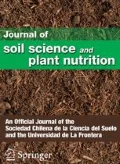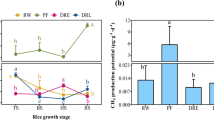Abstract
Aquands have a shallow profile and an impermeable layer that restricts water movement. Land use changes alter the physical structure of Aquands and soil air fluxes. The impacts of land use changes on the soil’s biological activity, nutrients’ dynamics, and the production of greenhouse gases (GHG) have not been investigated in Aquands. We investigated an Aquand soil under a second-growth native forest (sNF) and unmanaged naturalized grassland (NG) in southern Chile (41° S). Soil samples from each land use were taken in different seasons and analyzed in a laboratory to determine the potential soil respiration, N mineralization, denitrification, and nitrate reductase activity. GHG fluxes (CO2, N2O, and CH4) were collected from static chambers on the soil’s surface. Soil respiration rates were higher in the sNF, but were temporally variable in NG. Nitrogen dynamics was not as clearly influenced by soil use changes. CO2 emissions varied seasonally and were always higher in the NG during the summer, suggesting a dependency on temperature and the changing thermal profile, while the N2O and CH4 in Aquands showed no evident spatiotemporal effects related to the historical land use change. Seasonal dynamics of water and air in the profile of Aquands are relevant for the biological processes related to C and N transformations. Land use change amplifies the production of CO2 under favorable conditions, but the biological activity of soil and nutrient dynamics of Aquands respond more to changes in soil organic matter quality than to seasonal variation in the edaphic environment.






Similar content being viewed by others
References
Alef K (1995a) Nitrogen mineralization in soils. In: Alef K, Nannipieri P (eds) Methods in applied soil microbiology and biochemistry. Academic Press, London, pp 235–237
Alef K (1995b) Assay of dissimilatory nitrate reductase activity. In: Alef K, Nannipieri P (eds) Methods in applied soil microbiology and biochemistry. Academic Press, London, pp 283–284
Besoain E (1985) Los suelos. In: Tosso EJ (ed) Suelos volcánicos de Chile. Ministry of Agriculture, Santiago 723 p
Butterbach-Bahl K, Dannenmann M (2011) Denitrification and associated soil N2O emissions due to agricultural activities in a changing climate. Curr Opin Environ Sustain 3(5):389–395
Chen W, Wolf B, Zheng X, Yao Z, Butterbach-Bahl K, Brüggemann N, Han S, Liu C, Han X (2013) Carbon dioxide emission from temperate semiarid steppe during the non-growing season. Atmos Environ 64:141–149
Dalal R, Allen D (2008) Greenhouse gas fluxes from natural ecosystems. Aust J Bot 56:369–407
De Bruijn AMG, Butterbach-Bahl K, Blagodatsky S, Grote R (2009) Model evaluation of different mechanisms driving freeze–thaw N2O emissions. Agric Ecosyst Environ 133:196–207
Dec D, Zúñiga F, Thiers O, Paulino L, Valle S, Villagra V, Tadich I, Horn R, Dörner J (2017) Water and temperature dynamics of Aquands under different uses in southern Chile. J Soil Sci Plant Nutr 17(1):141–154
Dörner J, Dec D, Peng X, Horn R (2009) Efecto del cambio de uso en la estabilidad de la estructura y la función de los poros de un andisol (typic hapludand) del sur de Chile. J Soil Sci Plant Nutr 9(3):190–209
Dörner J, Dec D, Thiers O, Paulino L, Zúñiga F, Valle S, Martinez O, Horn R (2016) Spatial and temporal variability of physical properties of Aquands under different land uses in southern Chile. Soil Use Manag 32:411–421
Dörner J, Horn R, Dec D, Wendroth O, Fleige H, Zúñiga F (2017) Land use dependent change of soil mechanical strength and resilience of a shallow volcanic ash soil in southern Chile. Soil Sci Soc Am J 81. https://doi.org/10.2136/sssaj2016.11.0378
Dube F, Zagal E, Stolpe N, Espinosa M (2009) The influence of land-use change on the organic carbon distribution and microbial respiration in a volcanic soil of the Chilean Patagonia. For Ecol Manag 257:1695–1704
Hackl E, Bachmann G, Zechmeister-Boltenstern S (2004) Microbial nitrogen turnover in soils under different types of natural forest. For Ecol Manag 188:101–112
Hagerty S, van Groenigen K, Allison S, Hungate B, Schwartz E, Koch G, Kolka R, Dijkstra P (2014) Accelerated microbial turnover but constant growth efficiency with warming in soil. Nat Clim Chang 4:903–906
Hobbie SE (2015) Plant species effects on nutrient cycling: revisiting litter feedbacks. Trends Ecol Evol 30:357–363
Högberg P, Nordgren A, Buchmann N, Taylor AF, Ekblad A, Högberg MN, Nyberg G, Ottosson-Löfvenius M, Read DJ (2001) Large-scale forest girdling shows that current photosynthesis drives soil respiration. Nature 411:789–792
Hube S, Alfaro M, Scheers C, Brunk C, Ramírez L, Rowlings D, Grace P (2017) Effect of nitrification and urease inhibitors on nitrous oxide and methane emissions from an oat crop in a volcanic ash soil. Agric Ecosyst Environ 238:46–54
Huygens D, Boeckx P, Templer P, Paulino L, Van Cleemput O, Oyarzún C Müller C, Godoy R (2008) Mechanisms for retention of bioavailable nitrogen in volcanic rainforest soils. Nature Geosciences, 1(8):543–548
Linn D, Doran J (1984) Aerobic and anaerobic microbial populations in no-till and plowed soils. Soil Sci Soc Am J 48:794–799
Longeri L, Etchevers J, Venegas J (1979) Metodología de perfusión para estudios de nitrificación en suelos. Cienc Investig Agrar 6(4):295–299
Luo L, White RE, Ball PR, Tillman RW (1996) Measuring denitrification activity in soils under pasture: optimizing conditions for the short-term denitrification enzyme assay and effects of soil storage on denitrification activity. Soil Biol Biochem 28(3):409–417
Martins C, Nazaries L, Macdonald C, Anderson I, Singh B (2015) Water availability and abundance of microbial groups are key determinants of greenhouse gas fluxes in a dryland forest ecosystem. Soil Biol Biochem 86:5–16
Moinet G, Cieraad E, Hunt J, Fraser A, Turnbull M, Whitehead D (2016) Soil heterotrophic respiration is insensitive to change in soil water content but related to microbial access to organic matter. Geoderma 274:68–78
Morales E (2005) Diseño experimental a través del análisis de varianza y modelo de regresión lineal. Editorial Consultora Carolina. Valdivia, Chile, 248
Muñoz C, Paulino L, Monreal C, Zagal E (2010) Greenhouse gas (CO2 and N2O) emissions from soils: a review. Chil J Agric Res 70(3):485–497
Novoa R, Villaseca R (1989) Agroclimatic map of Chile. (In Spanish). Instituto de Investigaciones Agropecuarias, Ministerio de Agricultura, Santiago, Chile
Robarge WP, Edwards A, Johnson B (1983) Water and waste water analysis for nitrate via nitration of salicylic acid. Commun Soil Sci Plant Anal 14(12):1207–1215
Rowell DL (1994) Soil science: methods and applications. Longman Scientific & Technical, Singapore
Sadzawka A, Carrasco M, Grez R, Mora M, Flores H (2006) Métodos de análisis recomendados para los suelos de Chile. Revisión 2006. Instituto de Investigaciones Agropecuarias, Santiago
Saggar S, Jha N, Deslippe J, Bolan NS, Luo J, Giltrap DL, Kim D-G, Zaman M, Tillman RW (2013) Denitrification and N2O: N2 production in temperate grasslands: processes, measurements, modelling and mitigating negative impacts. Sci Total Environ 465:173–195
Sandoval M, Dörner J, Seguel O, Cuevas J, Rivera D (2012) Métodos de Análisis Físicos de Suelos. Universidad de Concepción. Publicaciones Departamento de Suelos y Recursos Naturales, Chillán, Chile, número 5, p 80
Singh SN, Tyagi L (2009) In: Sheldon AI, Barnhart EP (eds) Nitrous oxide emissions research progressNitrous oxide: sources, sinks and mitigation strategies. Nova Science Publisher, New York, pp 127–150
Thiers O, Gerding V, Lara A, Echeverría C (2007) Variación de la capa freática en un suelo Ñadi bajo diferentes tipos vegetacionales, X Región, Chile. In: Gonda H, Davel M, Loguercio G, Picco OA (eds) Libro de actas de eco reuniones. Primera reunión sobre forestación en la Patagonia EcoForestar 2007. Centro de Investigación y Extensión Forestal Andino Patagónica (CIEFAP), Esquel, pp 259–266
Van Cleemput O, Boeckx P (2002) Measurement of greenhouse gas fluxes. In Lal R (ed) Encyclopedia of Soil Science. Marcel Dekker. New York, pp 626–629
Wakelin SA, Gerard E, van Koten C, Banabas M, O’Callaghan M, Nelson PN (2016) Soil physicochemical properties impact more strongly on bacteria and fungi than conversion of grassland to oil palm. Pedobiologia 59:83–91
Wan S, Luo Y (2003) Substrate regulation of soil respiration in a tallgrass prairie: results of a clipping and shading experiment. Glob Biogeochem Cycles 17(2):1054–1065
Yanardag I, Zornoza R, Bastida F, Büyükkiliç-Yanardag A, Garcia C, Faz A, Mermut A (2017) Native soil organic matter conditions the response of microbial communities to organic inputs with different stability. Geoderma 295(1–9):1–9
Acknowledgements
Nelson Beas thanks the Scholarship V/2015/741 from Universidad de Guadalajara, Mexico, which made his Master’s program at the Universidad de Concepción, Chile, possible. Finally, we are also grateful for the hospitality of the landowners Don Alfredo and Sra. Elba, and Katherine Rebolledo for her technical support on analytical determinations in the laboratory.
Funding
This research project received funding from the Fondecyt grant 1130546.
Author information
Authors and Affiliations
Corresponding author
Ethics declarations
Conflict of Interest
The authors declare that they have no conflict of interest.
Additional information
Publisher’s Note
Springer Nature remains neutral with regard to jurisdictional claims in published maps and institutional affiliations.
Rights and permissions
About this article
Cite this article
Beas, N., Zúñiga, F., Dec, D. et al. Biological Properties and Greenhouse Gas Emissions in Two Different Land Uses of an Aquand. J Soil Sci Plant Nutr 19, 368–378 (2019). https://doi.org/10.1007/s42729-019-00039-6
Received:
Accepted:
Published:
Issue Date:
DOI: https://doi.org/10.1007/s42729-019-00039-6




